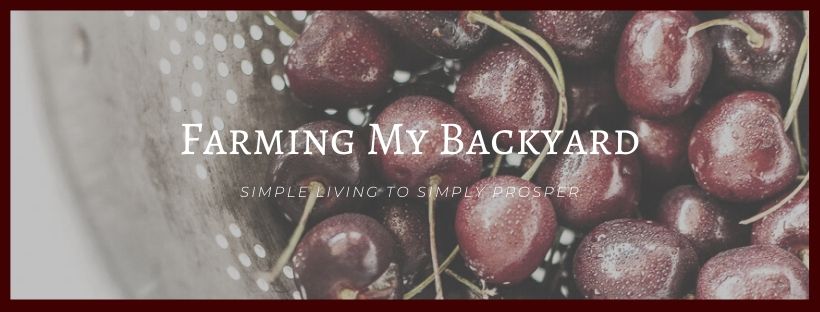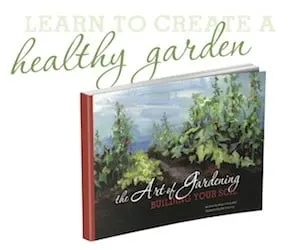When I first started gardening I figured I was a total fail at it. Everything I planted DIED. Even blackberry plants! Turns out there was a lot I didn’t know about gardening. There’s a little more to it than just sticking plants into the ground and blasting the hose at them occasionally. (Yeah, just a bit…). There’s one thing that can make a world of difference in your gardening success, the quality of your soil. Building soil is one of the best things you can do for your garden. Even if you start out with sub-par soil in your yard or homestead, you can improve it!
Related Post: 5 Ways To Have a Healthy Garden This Spring (And All Year!)

Learn More About Building Soil
I love books, really, really love books. And I enjoy gardening, even though I’m not the greatest at it. So I’m always on the look out for books about gardening, especially how I can get better results. When I received a free review copy of The Art of Gardening: Building Your Soil by Susan Vinskofski from Learning and Yearning I was super duper excited. (As a side note, this is a gorgeous e-book. I have never, ever read such a beautiful ebook!)
Start a Compost Bin
I’m sure if you aren’t already composting you might be sick of hearing everyone talk about how important composting is. But everyone is right! Composting is like magic where you take a bunch of refuse and turn it into garden awesomeness. If you are serious about building soil in your garden, start composting. I’ve had my own share of composting failures to go along with the gardening ones, but still I plug away.
It’s always good to have a game plan going in before you start a new project. The first part of The Art of Gardening; Building Your Soil is a great overview of composting including how to do it, what to include in your bin, troubleshooting when it’s not going exactly right, and how to use your finished compost. I highly suggest reading through it before you get started with your first composting endeavor. In fact, I still suggest if even if you’ve already started or have questions about particulars.
If you prefer to jump first look second, you can start composting by tying four pallets together with baling twine. Next, put in roughly fifty percent “brown” ingredients such as leaves and straw. Alternate your browns with fifty percent “green” ingredients such as chicken poop and kitchen scraps. Keep it damp, turn it and eventually you get finished compost.
Sheet Composting
In addition to maintaining a compost bin, building soil can also happen right in your garden. There are a few different methods for composting in place, or sheet composting. Lasagna gardens involve layering organic materials directly into the garden alternating, then allowing them to break down in place. The Back to Eden method is similar. It’s best started in fall by putting a thick layer of woods chips on the garden so they can break down all winter.
If you’re starting your garden in spring, but you like the sound of composting in place, The Art of Gardening, suggests starting with a lasagna garden, then switching to wood chips in the fall. It has tips on where to get great mulch for building soil. (I’m going to start mulching with alfalfa!) . And it also includes a list of amendments to increase specific nutrients in your soil and how much to add. Now excuse me while I add some dolomitic lime to my garden Be right back.
On word of caution on the wood chips though, is before you get a load, ask what trees are in that particular load. We got a load that was mostly pine, and it was much too acidic to be used on the garden. We ended up using that batch in the raspberry patch and in the goat yard, and the poor garden had to be content with straw for mulch.
What else do you need for a great garden?
Building soil is going to get your garden growing and off to a great start, but obviously it’s not the only thing you need to know. The second section of The Art of Gardening is dedicated to seeds. The kinds of seeds you plant can make all the difference on what you harvest, and I’m not talking about tomatoes versus corn here. Can you tell if your seeds are viable? Does it really matter if your plant heirloom, open pollinated, hybrid, GMO, or organic seeds? Whew! so many choices!
Preserving heritage varieties is important, and you can select for the plants that really excel in your specific property, but in order to that, you’ll want to start learning how to save your own seeds. Once you save them, it’s a good idea to know how to start them. Starting seeds is another thing that I epically fail at each year, so I appreciate all the experienced wisdom I can find. And then once you start them, when is it time to actually put them IN the garden? I’m a big fan of charts, and there’s a link to one for a really awesome spreadsheet in The Art of Gardening where you can enter your last frost date into and get custom planting dates. My husband was probably wondering why I was throwing fits about his printer not working….
Now That Your Garden Is Thriving…
Once you have your plants in the ground and they are happy and growing it’s time for fun stuff, such as a really awesome archway plant trellis. There’s a nice side bar with a super cool tomato trellis in the book that I’ve been drooling over. It’s a lot more attractive than the bamboo tepees I put together last summer.
Generally healthy soil means that you won’t be subject to many pests or diseases, but if they do strike, learn how to handle them so you don’t end up losing all the delicious results of your hard work. Speaking of delicious results, one great way to preserve your home grown food for later is by fermenting it (so much more than pickles!), or with recipes that really highlight your harvest. (Onion Butter…Parsnip Cake with Orange Infused Whipped Cream…delicious Tomato Sauce? Yes, please!).
Are you ready for an awesome garden and a delicious harvest? Start building soil now!
Want To Raise Happy Chickens?
Subscribe for our newsletter and get the free email course Intro To Backyard Chickens as well as a free printable checklist to walk you through step by step!


